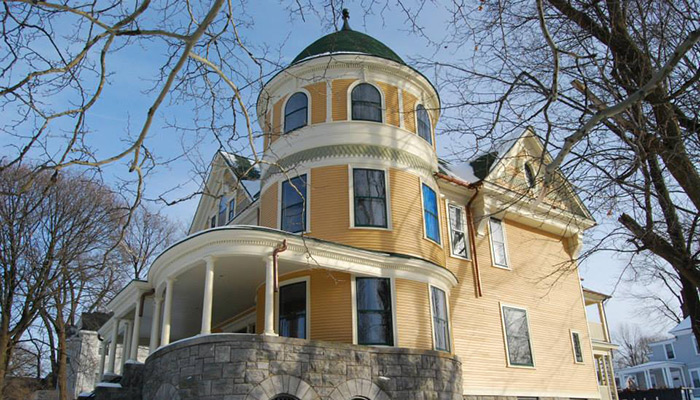The Old Neighborhood Part I
Stop #34
2004 East Genesee Street / Babcock-Shattuck House
- Built: ca. 1895
- Architect: unknown
The former Babcock-Shattuck House, also commonly known as the Jewish War Veterans’ Post 131, was when built one of the finest residential buildings in the area. Its intact exterior prominently serves as a reminder of the prosperity that this part of the City once enjoyed. Sited on a small hill overlooking East Genesee Street at Westcott Street, it functions visually and symbolically as the gateway to the Westcott neighborhood business and residential district. After years of neglect the building has been beautifully restored and once again will serve residential use, now housing four condominium apartments.
Built in the Queen Anne Revival style, the large wood-frame structure sits on a prominent rusticated limestone base. Its many attractive features include a spacious front porch overlooking East Genesee Street; a tower with a conical roof and a series of arched windows on its top floor; and an upper story Palladian window on the East Genesee facade. Constructed at a time when East Syracuse was opening up for intensive residential use, the grand house was a welcoming vision for the turn-of-the-century professional class that began to settle the area in great numbers at the time. The city atlases of 1892, 1904 and 1924 show how quickly this area (Ward 14) developed, and how central a role the Babcock-Shattuck house played.
Erected on part of a larger lot owned by W.M. Knapp, the Babcock house was designed with great sensitivity to its site, and serves as a remarkable and essential visual anchor to the neighborhood.
The house was built as a private residence and first mentioned in the city directory of 1895 as the residence and office of Dr. Archer D. Babcock (1870-1939). Babcock, who became a prominent Syracuse physician and surgeon and founding member of the staff of Crouse-Irving Hospital appears to have occupied the house until 1913. He later served in World War I achieved the rank of Lt. Colonel and returned to head the U.S. Veteran’s Bureau in Syracuse.
One of the earliest notices of the house is from the Syracuse Sunday Herald social announcements of January 10, 1897, when:
“Mrs Archer D. Babcock and Miss Blanche Baxter are to give a reception at Mrs Babcock’s home in East Genesee Street next Thursday in honor of Miss Josephine Baxter, whose engagement to Lucius Leonard has just been announced.”
A few months later we read in the Syracuse Herald (August 8, 1897) of a social party, including the Babcocks, driving out to Green Lake for lunch:
“Several people drove to Green lake Thursday afternoon, where they had their luncheon. Those who enjoyed the afternoon’s pleasure were: Dr. and Mrs. Archer D. Babcock, Mrs. M. F. Baxter, Miss Frane Moulton, Lucius Leonard, Mrs. George S. Leonard, Christopher C. Bradley, jr., Miss Blanche Baxter, Miss Sarah Baxter, and Miss Josephine Baxter.”
In 1913, the house was owned by Frank M. Shattuck (1888-1959?), a member of a prominent Syracuse business family, and himself manager of the Syracuse Schrafft’s confectionery stores for forty years. In 1925, the house was listed as the residence of Harry H. Elmer (1868-1933), vice-president of the Britton Corp. and treasurer and manager of Globe Malleable Iron and Steel Co. Elmer, as general manager of Haines automobile company, was known as the inventor of a heavy oil type engine which was to revolutionize automobile and tractor and design, allegedly allowing 250-300 miles to the gallon. Plans were being made to produce the engine when Elmer died in 1933, at which time work stopped.
From 1931-1933 the house served as the 16th-17th Ward Republican Club. The building was sold in 1947 (reportedly for $6,000) to become the home of Onondaga Post No. 131 of the Jewish War Veterans of the United States of America (JWV). The JWV, which had previously rented space on Cedar Street, engaged in fund raising drive to collect the $30,000 needed for the rehabilitation of the building until at least 1953, when a newspaper article reported restoration work in progress. Ownership in the property belonged to the 2000 East Genesee Street Corporation, which was made of JWV members, and which, according to JWV Executive committee member Seymour Block, leased the building to the JWV for $1.00 a year.
JWV was founded in March 1896 in New York City by Jewish Veterans of the Civil War. At that time the organization was called the Hebrew Union War Veterans. In Syracuse, the organization was founded in 1936, and soon became active in protests against the Nazi presence in Syracuse, picketing a Nazi Bund headquarters on East Genesee and a downtown bank which displayed Nazi symbols. The Syracuse JWV became particularly active shortly after World War II, when so many Jewish Veterans returned home.
The JWV occupied the building for more than four decades, finally selling the house and moving to new quarters in DeWitt, in the early 1990s. During that time the building served as a meeting and activity center for the JWV. The Post was an active place. In addition to bingo, which was the first Jewish bingo in the city, meetings and memorial services regularly took place. Downstairs was a member lounge, to the left was a special memorial room with the names of Syracuse area Jewish war dead, which was equipped with a small Ark and even a Torah scroll. Before erecting its own building further east, Congregation Young Israel used these facilities for religious services. On the right hand side was a room with a pool table in back. Upstairs was a big meeting room, and the caretaker’s apartment.
The recent restoration project was carried out by the University Neighborhood Preservation Association with Crawford & Stearns as the project architects.
